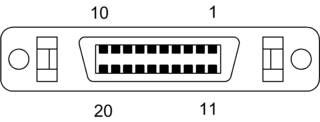Related Research Articles

Video is an electronic medium for the recording, copying, playback, broadcasting, and display of moving visual media. Video was first developed for mechanical television systems, which were quickly replaced by cathode-ray tube (CRT) systems which, in turn, were replaced by flat panel displays of several types.

Low-voltage differential signaling (LVDS), also known as TIA/EIA-644, is a technical standard that specifies electrical characteristics of a differential, serial signaling standard. LVDS operates at low power and can run at very high speeds using inexpensive twisted-pair copper cables. LVDS is a physical layer specification only; many data communication standards and applications use it and add a data link layer as defined in the OSI model on top of it.

The display resolution or display modes of a digital television, computer monitor or display device is the number of distinct pixels in each dimension that can be displayed. It can be an ambiguous term especially as the displayed resolution is controlled by different factors in cathode ray tube (CRT) displays, flat-panel displays and projection displays using fixed picture-element (pixel) arrays.
A thin-film-transistor liquid-crystal display is a variant of a liquid-crystal display that uses thin-film-transistor technology to improve image qualities such as addressability and contrast. A TFT LCD is an active matrix LCD, in contrast to passive matrix LCDs or simple, direct-driven LCDs with a few segments.

A composite monitor or composite video monitor is any analog video display that receives input in the form of an analog composite video signal to a defined specification. A composite video signal encodes all information on a single conductor; a composite cable has a single live conductor plus earth. Other equipment with display functionality includes monitors with more advanced interfaces and connectors giving a better picture, including analog VGA, and digital DVI, HDMI, and DisplayPort; and television (TV) receivers which are self-contained, receiving and displaying video RF broadcasts received with an internal tuner. Video monitors are used for displaying computer output, closed-circuit television and other applications requiring a two-dimensional monochrome or colour image.

The VESA Digital Flat Panel (DFP) interface standard specifies a video connector and digital TMDS signaling for flat-panel displays. It features 20 pins and uses the PanelLink protocol; the standard is based on the preceding VESA Plug and Display (P&D) standard, ratified in 1997. Unlike the later, electrically-compatible Digital Visual Interface, DFP never achieved widespread implementation.

Flat Panel Display Link, more commonly referred to as FPD-Link, is the original high-speed digital video interface created in 1996 by National Semiconductor. It is a free and open standard for connecting the output from a graphics processing unit in a laptop, tablet computer, flat panel display, or LCD television to the display panel's timing controller.

The Texas Instruments DaVinci is a family of system on a chip processors that are primarily used in embedded video and vision applications. Many processors in the family combine a DSP core based on the TMS320 C6000 VLIW DSP family and an ARM CPU core into a single system on chip. By using both a general-purpose processor and a DSP, the control and media portions can both be executed by separate processors.
Universal Flash Storage (UFS) is a flash storage specification for digital cameras, mobile phones and consumer electronic devices. It was designed to bring higher data transfer speed and increased reliability to flash memory storage, while reducing market confusion and removing the need for different adapters for different types of cards. The standard encompasses both packages permanently attached (embedded) within a device (eUFS), and removable UFS memory cards.

The Display Serial Interface (DSI) is a specification by the Mobile Industry Processor Interface (MIPI) Alliance aimed at reducing the cost of display controllers in a mobile device. It is commonly targeted at LCD and similar display technologies. It defines a serial bus and a communication protocol between the host, the source of the image data, and the device which is the destination. The interface is closed source, which means that the specification of the interface is not open to the public. The maintenance of the interface is the responsibility of the MIPI Alliance. Only legal entities can be members. These members or the persons commissioned and approved by them have access to the specification in order to use it in their possible applications.
MIPI Alliance is a global business alliance that develops technical specifications for the mobile ecosystem, particularly smart phones but including mobile-influenced industries. MIPI was founded in 2003 by Arm, Intel, Nokia, Samsung, STMicroelectronics and Texas Instruments.

UniPro is a high-speed interface technology for interconnecting integrated circuits in mobile and mobile-influenced electronics. The various versions of the UniPro protocol are created within the MIPI Alliance, an organization that defines specifications targeting mobile and mobile-influenced applications.
MSM7000 is a series of system-on-a-chip processors manufactured by Qualcomm for handheld devices, especially smartphones.
V-by-One HS is an electrical digital signaling standard that can run at faster speeds over inexpensive twisted-pair copper cables than Low-voltage differential signaling, or LVDS. It was originally developed by THine Electronics, Inc. in 2007 for high-definition televisions but since 2010 V-by-One HS has been widely adopted in various markets such as document processing, automotive infotainment systems, industrial cameras and machine vision, robotics and amusement equipments.
The Camera Serial Interface (CSI) is a specification of the Mobile Industry Processor Interface (MIPI) Alliance. It defines an interface between a camera and a host processor. The latest active interface specifications are CSI-2 v3.0, CSI-3 v1.1 and CCS v1.0 which were released in 2019, 2014 and 2017 respectively.

5K resolution refers to display formats with a horizontal resolution of around 5,000 pixels. The most common 5K resolution is 5120 × 2880, which has an aspect ratio of 16∶9 with around 14.7 million pixels, with exactly twice the linear resolution of 1440p and four times that of 720p. This resolution is typically used in computer monitors to achieve a higher pixel density, and is not a standard format in digital television and digital cinematography, which feature 4K resolutions and 8K resolutions.
S5P4418 is a system-on-a-chip (SoC) based on the 32-bit ARMv7-A architecture developed by Samsung Electronics for tablets and cell-phones

I3C is a specification to enable communication between computer chips by defining the electrical connection between the chips and signaling patterns to be used. Short for "Improved Inter Integrated Circuit", the standard defines the electrical connection between the chips to be a two wire, shared (multidrop), serial data bus, one wire (SCL) being used as a clock to define the sampling times, the other wire (SDA) being used as a data line whose voltage can be sampled. The standard defines a signalling protocol in which multiple chips can control communication and thereby act as the bus controller.
M-PHY is a high speed data communications physical layer protocol standard developed by the MIPI Alliance, PHY Working group, and targeted at the needs of mobile multimedia devices. The specification's details are proprietary to MIPI member organizations, but a substantial body of knowledge can be assembled from open sources. A number of industry standard settings bodies have incorporated M-PHY into their specifications including Mobile PCI Express, Universal Flash Storage, and as the physical layer for SuperSpeed InterChip USB.
The LG G7 ThinQ, commonly referred to as just LG G7, is an Android smartphone developed by LG Electronics as part of the LG G series. It was officially announced on May 2, 2018, after about a week of official leaks by LG. It is the second product from LG that uses the ThinQ branding. The device serves as the successor to the 2017 LG G6.